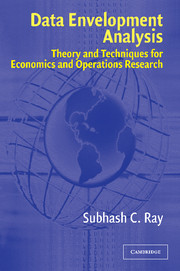Book contents
- Frontmatter
- Contents
- Preface
- 1 Introduction and Overview
- 2 Productivity Efficiency, and Data Envelopment Analysis
- 3 Variable Returns to Scale: Separating Technical and Scale Efficiencies
- 4 Extensions to the Basic DEA Models
- 5 Nonradial Models and Pareto–Koopmans Measures of Technical Efficiency
- 6 Efficiency Measurement without Convexity Assumption: Free Disposal Hull Analysis
- 7 Dealing with Slacks: Assurance Region/Cone Ratio Analysis, Weak Disposability, and Congestion
- 8 Efficiency of Merger and Breakup of Firms
- 9 Efficiency Analysis with Market Prices
- 10 Nonparametric Approaches in Production Economics
- 11 Measuring Total Productivity Change over Time
- 12 Stochastic Approaches to Data Envelopment Analysis
- 13 Looking Ahead
- References
- Index
5 - Nonradial Models and Pareto–Koopmans Measures of Technical Efficiency
Published online by Cambridge University Press: 24 November 2009
- Frontmatter
- Contents
- Preface
- 1 Introduction and Overview
- 2 Productivity Efficiency, and Data Envelopment Analysis
- 3 Variable Returns to Scale: Separating Technical and Scale Efficiencies
- 4 Extensions to the Basic DEA Models
- 5 Nonradial Models and Pareto–Koopmans Measures of Technical Efficiency
- 6 Efficiency Measurement without Convexity Assumption: Free Disposal Hull Analysis
- 7 Dealing with Slacks: Assurance Region/Cone Ratio Analysis, Weak Disposability, and Congestion
- 8 Efficiency of Merger and Breakup of Firms
- 9 Efficiency Analysis with Market Prices
- 10 Nonparametric Approaches in Production Economics
- 11 Measuring Total Productivity Change over Time
- 12 Stochastic Approaches to Data Envelopment Analysis
- 13 Looking Ahead
- References
- Index
Summary
Introduction
One major problem with a radial measure of technical efficiency is that it does not reflect all identifiable potential for increasing outputs and reducing inputs. In economics, the concept of efficiency is intimately related to the idea of Pareto optimality. An input–output bundle is not Pareto optimal if there remains the possibility of any net increase in outputs or net reduction in inputs. When positive output and input slacks are present at the optimal solution of a CCR or BCC DEA LP problem, the corresponding radial projection of an observed input–output combination does not meet the criterion of Pareto optimality and should not qualify as an efficient point. Note that this problem arises not only for input- or output-oriented models but also for graph efficiency or directional distance function models.
In this chapter, we consider a number of nonradial models that allow reduction of individual inputs and/or increase in individual outputs at different rates. The output- and input-oriented nonradial models developed independently of the DEA models by Färe and Lovell (FL) (1978) provide appropriately oriented summary measures of technical efficiency. Although the output-oriented nonradial projection allows no slacks in outputs, it does not exclude input slacks, however. Similarly, the input-oriented projection permits output slacks. The more general Pareto–Koopmans measure proposed by Pastor, Ruiz, and Sirvent (1999), on the other hand, does not permit any slack in either any input or any output at the efficient projection.
- Type
- Chapter
- Information
- Data Envelopment AnalysisTheory and Techniques for Economics and Operations Research, pp. 111 - 133Publisher: Cambridge University PressPrint publication year: 2004



